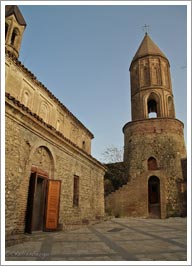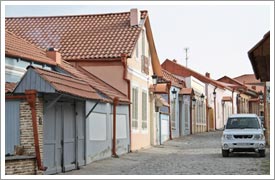Georgian Culture

Despite repeated periods of foreign occupation, Georgia’s rich and ancient historical roots date back thousands of years, lending the country a unique national heritage and culture that will excite any cultural enthusiast. Georgia’s monumental architecture, unique traditional music and colorful dances, world-renowned cinema, theater and art combine to give the country, and its hospitable and gracious citizens, a strong sense of national identity.
The development of the nation is linked to King Parnavaz’s endeavor to unite Georgia in the 3rd century BC. At that time people from various parts of the country spoke different languages and had little in common. Western Georgia, for example, was inhabited by Colchian, proto-Abkhazian and proto-Svan tribes, with Greek settlements along the Black Sea shore.
The language was closer to contemporary Georgian in the eastern and southern regions of the country. King Parnavaz successfully united the western and eastern Georgian states into a single state. He also invented the first Georgian alphabet and became the founder of the written Georgian language, which is one of the oldest languages in the world today. This sense of a unified identity is the glue that firmly binds the people of Georgia together and gives them a clear self-identity of who they are as Georgians.
Georgians do not refer to themselves as Georgians, though. Instead, they call themselves Kartvelebi and their land is called Sakartvelo. These names were taken from Kartlos, a pagan god that is said to be the father of all Georgians. The foreign name of Georgia has been used all over Western Europe, and it is mistakenly believed to come from the country’s patron saint, St. George.
Contrary to popular belief, the term Georgian does not refer to St George, but rather from the ancient Persian word, Gorg, Kurj or Gurj, which means wolf, a totemic symbol of Georgian culture. Georgia is often referred to as the land of the wolf because the grey wolf makes its home there. The grey wolf has been part of Russian culture and folklore for hundreds of years.
Others believe that the term ‘Georgian’ is derived from the Greek word, georgios, which means farmer or cultivator of land, because when the Greeks came to Georgia, they saw the Georgians working the land. This name seems most apt given the Georgian’s love for cultivating the land.
Historically, Georgians have a unique cultural identity. This self- identity is founded primarily on linguistic tradition. Georgian is a South Caucasian language that is called Kartveli by its speakers. As the official language of Georgia, it is spoken by about 71% of the population, with Russian being spoken by 9% of the population, Armenian by 7%, Azeri by 6%, and various other languages are spoken by the remaining 7%.
Furthermore, population groups that are part of different ethno-linguistic groups, such as Ossetians, Abkhazians, Armenians, Greeks, and Kurds, are not regarded as Georgians. Yet, there are some exceptions to this rule that apply to Jews that speak Georgian as a native language and have last names that contain Georgian endings.
Georgians are also separated into smaller regional provincial ethno-cultural entities, each with its own unique cultural flavor in terms of their peculiar traditions, customs, folklore, dress, cuisine and they may even speak another language. Yet, what binds them all together is the fact that they safeguard and share a mutual identity, literary languages and a basic set of cultural values.
Values
Georgians are said to among the most hospitable people on Earth. They truly believe that guests are from God, and they have strong traditions of chivalry and codes of personal honor.
The national culture firmly values respect for women. It is good to know that legislation allows room for a woman’s right to take the children after a divorce. Women receive pregnancy leave and earlier retirements. They also do not have to take part in compulsory military service. On the other hand, top-level political and business jobs are less attainable for women and only a few are in the government. Furthermore, women are not allowed to become a priest in the Orthodox Church or a mullah among Muslims.
Georgian society is patriarchal, and in a traditional family, the mother and daughters usually cook, clean and take care of the household chores. This might offend many politically correct Westerners, yet this is very normal in Georgia, as gender roles are still more clearly defined and observed than in the West.
Most urban women work if they have the opportunity, placing many women in the role of both being a housewife and a breadwinner. Today, many young educated women are paid better than their husbands or fathers, so conventional stereotypes of gender-defined social roles are shifting slightly.
Basic households in most large cities are a nuclear family, but it isn’t unusual for grandparents to live with their families and assist in raising the children. In rural and mountainous areas you will find several extended families living together. The patriarch of the family controls the resources and he assigns tasks to everyone on the farm or land that they own. Younger members of such a family gradually split off from the main family by building separate housing in the same location.
The concept of kinship in Georgia still bears a great sense of weightiness. Relatives up to the third of fourth generations are regarded as close, and are required to take part in both joyous events and in hardships. Kin are expected to attend significant social events, such as weddings and funerals, and it is severely frowned upon if someone neglects their social duties by not showing up at these kinds of events.
Urbanism and Architecture
Settlements in Georgia all have an overlooking Church built on a nearby hill or in its centre. Yet, it is unfortunate that many Churches were destroyed when Georgia was ruled by the Soviet Union. Many of them were also turned into storehouses. Today we can still see how urban architecture still bears strong remnants of the Soviet influence. Government building and sculptures of this era are bleak and shallow. In the 1970 and 1980s a new architectural tradition surfaced that allowed room for light and better use of space, yet it lacked creativity.



